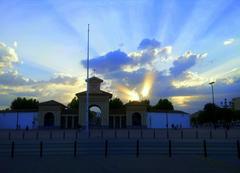
Discover the Charms of Albacete: A Local’s Guide
Published Date: 13/08/2024
Welcome to Albacete
Imagine a place where the echoes of ancient cave paintings, Roman settlements, and Moorish villages intertwine with the vibrant energy of modern-day Spain. Welcome to Albacete, a city that wears its rich history and culture like a colorful tapestry. Nestled in the heart of Spain’s Castile-La Mancha region, Albacete is a treasure trove of fascinating stories and unforgettable experiences. From the prehistoric cave paintings in Cueva del Niño to the bustling Roman settlement of Libisosa, this city has witnessed the rise and fall of civilizations.
Fast forward to the Moorish era, when Albacete, known then as Al-Basīṭ, was a small village nestled in the flat terrain. The Christian reconquest in the 13th century breathed new life into the city, setting the stage for its role in pivotal events like the Battle of Almansa in 1707. The 19th century brought agricultural and economic growth with the construction of the María Cristina Canal and established Albacete as a legal powerhouse with the creation of the Audiencia Territorial.
Today, Albacete is a city that pulses with life and culture. Famous for its cutlery industry, this city has been crafting coveted blades since the 16th century. The Feria de Albacete, held every September, is an internationally acclaimed festival that draws visitors from all over the world. Whether you’re exploring the Gothic marvel of the Cathedral of San Juan Bautista or savoring the local delicacies like gazpacho manchego, Albacete offers a unique blend of history, culture, and culinary delights.
So, pack your bags and get ready to embark on an unforgettable journey through time and culture in Albacete. Download Audiala, your perfect travel companion, to unlock the city’s secrets and enrich your adventure with expertly curated audio guides. Let’s dive into the vibrant world of Albacete!
Your Albacete Adventure Map
- Historical Background
- Ancient Inhabitants and Early Settlements
- Moorish Influence and Christian Reconquest
- Development in the 19th Century
- 20th Century and the Spanish Civil War
- Modern Albacete
- Architectural and Cultural Heritage
- Festivals and Traditions
- Natural Beauty and Outdoor Activities
- Culinary Delights
- Visitor Tips for Albacete, Albacete Province, Spain
- Best Time to Visit
- Getting There
- Accommodation
- Local Cuisine
- Sightseeing and Attractions
- Outdoor Activities
- Cultural Events
- Shopping
- Practical Information
Historical Background
Ancient Inhabitants and Early Settlements
Picture this: Albacete, with its roots entangled in the mists of time, showcases cave paintings in the Cueva del Niño and Cueva de la Vieja. These ancient artworks whisper stories of the region’s earliest dwellers.
Fast forward to the Roman era, where Albacete was a vital cog in the grand machinery of regions like Carpetania and Celtiberia. Imagine walking through Libisosa, a bustling Roman settlement, and feeling the echoes of its historical relevance. The Visigothic period added another layer with Tolmo de Minateda, a settlement of great import.
Moorish Influence and Christian Reconquest
Albacete, originally known as البسيط (Al-Basīṭ) meaning “The Flat,” was a small Moorish village nestled in the flat terrain. It’s fascinating to think about the two significant battles in 1145 and 1146 (Britannica) that painted the landscape with tales of Moorish and Christian confrontations.
The Christian reconquest in the 13th century gave Albacete a fresh start, and by 1365, it was refounded. The city’s role in the War of the Spanish Succession, especially the decisive Battle of Almansa in 1707, marked a turning point in Spanish history.
Development in the 19th Century
The 19th century was a renaissance for Albacete. Picture the construction of the María Cristina Canal, which transformed malarial swamps into fertile lands, sparking agricultural and economic growth. The rivalry with Chinchilla for provincial capital status adds a dramatic flair, but the definitive 1833 territorial division crowned Albacete as the capital (Wikipedia).
In 1834, Albacete became a legal powerhouse with the establishment of an Audiencia Territorial, governing over several provinces and cementing its regional authority.
20th Century and the Spanish Civil War
Albacete navigated through the 20th century with resilience. During the Spanish Civil War, it was the heartbeat of the International Brigades, housing volunteers from around the world who fought against Franco. This era etched unforgettable marks on Albacete’s historical canvas.
Modern Albacete
Today, Albacete pulsates with life and culture. Famous for its cutlery industry, it has been crafting coveted blades since the 16th century. Walking through the city, you’ll appreciate its accessibility, thanks to its flat terrain and removal of architectural barriers (Wikipedia).
The Feria de Albacete, a September spectacle, has gained international acclaim, drawing visitors to experience its vibrant traditions and festivities.
Architectural and Cultural Heritage
Albacete’s architectural gems are a testament to its rich past. The Cathedral of San Juan Bautista, a Gothic marvel from the 16th century, and the early 20th-century Pasaje de Lodares arcade are must-see landmarks.
The Museum of Albacete offers an immersive journey through the region’s history, showcasing archaeological finds, traditional crafts, and contemporary art. The Albacete School of Artists has nurtured numerous talented creatives, adding to the city’s artistic legacy.
Festivals and Traditions
Albacete’s festivals are legendary. The Feria de Albacete in September is a riot of music, dance, and gastronomic delights. The annual Carnival with its vibrant parades and elaborate costumes is another highlight.
Natural Beauty and Outdoor Activities
Albacete’s natural landscapes are stunning. The Lagunas de Ruidera Nature Reserve and Sierra de Alcaraz are perfect for hiking and cycling. The Júcar Valley, dotted with traditional towns and oak groves, offers picturesque vistas. The Montes de Chinchilla and Montiel Fields are also worth exploring.
Culinary Delights
As a UNESCO Creative City of Gastronomy, Albacete’s culinary scene is mouth-watering. From gazpacho manchego to migas, the local dishes are a treat for foodies. The city’s restaurants offer a delightful mix of traditional and international cuisines.
Visitor Tips for Albacete, Albacete Province, Spain
Ever heard of a city where flamingos wade in saltwater lagoons and centuries-old fairs light up the night? Welcome to Albacete, Spain’s best-kept secret! Think of Albacete as your cool, slightly quirky friend who always knows the best spots to hang out.
Best Time to Visit
Albacete experiences a Mediterranean climate with hot summers and mild winters. The best time to visit is during the spring (April to June) and autumn (September to November) when the weather is pleasant and the city hosts several cultural events. The Albacete Fair in September is a highlight, attracting visitors from all over the world.
Getting There
Albacete is well-connected by road, rail, and air. The city is accessible via the A-31 motorway, which links it to Madrid and Alicante. The Albacete-Los Llanos Airport offers domestic flights, while the Albacete Railway Station provides high-speed AVE train services to major cities like Madrid and Valencia.
Accommodation
Albacete offers a range of accommodation options to suit different budgets. For a luxurious stay, consider the Gran Hotel Albacete, a historic hotel located in the city center. Budget travelers can opt for hostels or guesthouses like Hostal Atienzar, which offers comfortable rooms at affordable rates.
Local Cuisine
Albacete is renowned for its rich culinary heritage. Don’t miss trying the local specialties such as:
- Miguelitos de La Roda: A delicious pastry filled with cream.
- Pisto Manchego: A vegetable stew made with tomatoes, peppers, and zucchini.
- Atascaburras: A traditional dish made from salt cod, potatoes, and garlic.
For a fine dining experience, visit Maralba, a Michelin-starred restaurant known for its innovative take on traditional Manchego cuisine.
Sightseeing and Attractions
Museum of Albacete: Located in the Abelardo Sánchez Park, this museum offers a comprehensive look into the region’s history and culture. It features sections on archaeology, fine arts, and ethnology. Highlights include the Iberian-Roman head of El Tolmo and the sword of La Hoya (Museum of Albacete).
Cathedral of San Juan Bautista: This Gothic cathedral, whose construction began in 1515 and was completed in the 20th century, is a must-visit. It houses remarkable Renaissance columns, a 16th-century vestry, and an interesting Renaissance altarpiece (Cathedral of San Juan Bautista).
Pasaje de Lodares: A stunning example of early 20th-century modernism, this covered shopping arcade is one of the city’s most iconic landmarks. It connects High Street and Tinte Street and features beautiful ironwork and glass (Pasaje de Lodares). Don’t miss the tiny, family-run tapas bars hidden in the side streets—each with its own delicious secret.
Outdoor Activities
Natural Parks: Albacete is home to two natural parks, the Sierra de Alcaraz and the Sierra del Segura. These parks offer numerous hiking and biking trails, making them perfect for outdoor enthusiasts (Natural Parks).
Lagoon of Pétrola: This saltwater lagoon is a haven for birdwatchers. It is one of the few places in Spain where flamingos are born. The lagoon is a transit point for migratory birds in autumn and winter, and it is ideal for spotting Anatidae in spring (Lagoon of Pétrola).
Cultural Events
Albacete Fair: Held every September, this fair is one of the most important events in the city. It features a variety of activities, including parades, concerts, and traditional dances. The fairgrounds are filled with stalls selling local crafts and food (Albacete Fair).
Tamborada de Hellín: This drumming festival, held during Easter week in the nearby town of Hellín, is a unique cultural experience. Thousands of drummers fill the streets, creating a mesmerizing and rhythmic spectacle (Tamborada de Hellín).
Shopping
Albacete is famous for its cutlery, and no visit is complete without purchasing a locally made knife. The city has several shops specializing in high-quality cutlery, such as Cuchillería Simón. Challenge: Find the oldest knife at Cuchillería Simón and ask the shopkeeper for its story. Additionally, the Pasaje de Lodares offers a variety of boutiques and shops where you can find unique souvenirs.
Practical Information
Language: Spanish is the official language. While English is not widely spoken, basic phrases and a translation app can be helpful.
Currency: The currency used is the Euro (€). Credit cards are widely accepted, but it’s advisable to carry some cash for small purchases. Think of the Euro as your magic key to Albacete. Just a heads-up—cash is king in tiny tapas bars!
Safety: Albacete is generally safe for tourists. However, like any other city, it’s important to stay vigilant, especially in crowded areas.
Health: Spain has a high standard of healthcare. EU citizens can use their European Health Insurance Card (EHIC) for medical services. Non-EU visitors should consider travel insurance.
Local Customs: Spaniards are known for their warm hospitality. It’s customary to greet people with a handshake or a kiss on both cheeks. In Albacete, a kiss on both cheeks is not just a greeting—it’s a warm welcome into their vibrant culture! Tipping is appreciated but not obligatory; rounding up the bill or leaving a small amount is sufficient.
By following these tips, visitors can make the most of their trip to Albacete, enjoying its rich history, vibrant culture, and beautiful landscapes. Ready to uncover Albacete’s secrets? Download Audiala, your perfect travel companion, for expert insights and hidden gems. Explore with us and make your trip unforgettable!
Unlock Albacete with Audiala
Albacete is more than just a city; it’s a living testament to the resilience and creativity of its people. From its ancient roots to its modern-day vibrancy, Albacete offers a captivating saga that spans centuries. The city’s rich cultural tapestry is woven with threads of ancient cave paintings, Moorish influences, and pivotal historical events like the Battle of Almansa. Its architectural gems, such as the Cathedral of San Juan Bautista and the Pasaje de Lodares, stand as proud monuments to its storied past.
But Albacete is not just about history. Its vibrant festivals, like the Feria de Albacete and the Tamborada de Hellín, bring the streets to life with music, dance, and colorful parades. The city’s culinary scene, recognized as a UNESCO Creative City of Gastronomy, offers mouth-watering delights that are sure to satisfy any foodie’s cravings. And let’s not forget the stunning natural landscapes, from the Lagunas de Ruidera Nature Reserve to the Sierra de Alcaraz, perfect for hiking and outdoor adventures.
Albacete is a city that invites you to explore, experience, and enjoy. So why wait? Download Audiala, your perfect travel companion, to unlock Albacete’s secrets and enrich your journey with expertly curated audio guides. Embark on an unforgettable adventure and discover the magic of Albacete for yourself!
Sources and Inspirations
- Historical Background, 2024, Research Data https://en.wikipedia.org/wiki/Province_of_Albacete
- Visitor Tips for Albacete, Albacete Province, Spain, 2024, Research Data https://www.spain.info/en/region/albacete-province/
- Albacete Fair, 2024, Research Data https://www.spain.info/en/region/albacete-province/
- María Cristina Canal, 2024, Research Data https://www.britannica.com/place/Albacete-Spain
- Cutlery Industry, 2024,Research Data https://facts.net/world/cities/46-facts-about-albacete/
- Feria de Albacete, 2024, Research Data https://en.wikipedia.org/wiki/Albacete
- Cathedral of San Juan Bautista, 2024, Research Data https://facts.net/world/cities/46-facts-about-albacete/
- Gazpacho Manchego, 2024, Research Data https://facts.net/world/cities/46-facts-about-albacete/
- Lagunas de Ruidera Nature Reserve, 2024, Research Data https://www.spain.info/en/destination/albacete/
- Sierra de Alcaraz, 2024, Research Data https://www.spain.info/en/destination/albacete/
- Tamborada de Hellín, 2024, Research Data https://www.spain.info/en/region/albacete-province/








